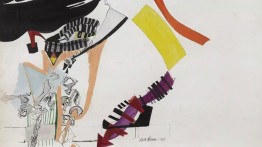Eva Hesse

One of America’s foremost postwar artists, Eva Hesse (1936–70) was a German-born American artist who had a prolific yet brief career. Known for the rigor of her mixed media innovations, she left a considerable body of drawings and over seventy pieces of sculpture, which unlike much of the art of the mid and late 1960s, had an associative quality, a hint of chance and randomness, a wry humor, and were deeply personal. As one critic put it, her work was frequently on the “verge of uncontrollability” and incorporated latex, plastic, rubber, resin, and other industrial materials to imply the messy, complex qualities of nature and bodies.
After The Cooper Union, where she studied with, among others, Josef Albers, she attended Yale University where she received her Bachelor of Fine Arts in 1959. Hesse taught at the School of Visual Arts in New York from 1968 to 1969, and at Oberlin College in 1968. Two years after her death, her sculptures and drawings were shown at the Guggenheim Museum in New York. Her work is now held in the permanent collections of Oberlin College and the Whitney Museum of Art in New York, among others. Hesse received the 1984 Augustus Saint-Gaudens Award. She was inducted into the Cooper Union Hall of Fame in 2009. She was the subject of Marcie Begleiter's 2016 documentary, Eva Hesse.




